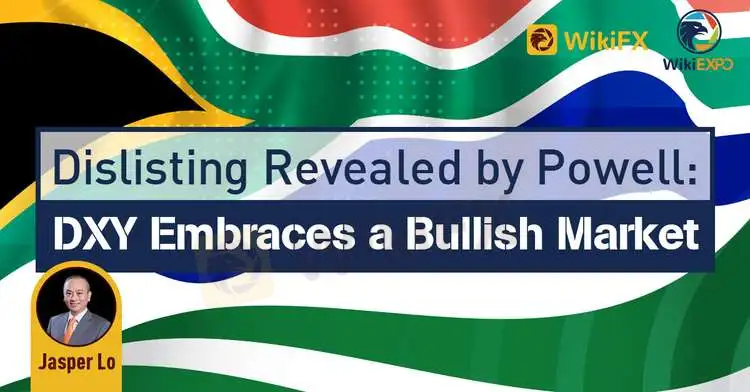简体中文
繁體中文
English
Pусский
日本語
ภาษาไทย
Tiếng Việt
Bahasa Indonesia
Español
हिन्दी
Filippiiniläinen
Français
Deutsch
Português
Türkçe
한국어
العربية
Dislisting Revealed by Powell: DXY Embraces a Bullish Market
Abstract:Powell has implied early that his attitude to the prospect of the American economy is perfectly optimistic because of its turning point characterized by a revving economic recovery from late February to early April which was shown in the latest Beige Book of the Federal Reserve (Fed).

Powell has implied early that his attitude to the prospect of the American economy is perfectly optimistic because of its turning point characterized by a revving economic recovery from late February to early April which was shown in the latest Beige Book of the Federal Reserve (Fed). At the same time, Powell has explicitly noted that the Fed is going to cut down the bond purchase followed by interest-rate rises, a delisting-related comment made by him in public for the second time. It is believed that he is paving way for tight monetary policies and equipping the financial market with preparation.
Fed had to save the market with massive quantitative easing (QE) during the financial crisis in the US and cope with the European debt crisis by means of QE2-3 again. Not until the Q1 in 2013 did Bernanke, the Fed Chair at that moment, disclose that delisting might be paved the way for by reducing the bond purchase in the future. He announced the delisiting in his final Feds meeting at the end of the same year, contracting the bond purchase from USD 85 billion then to USD 75 billion and reducing mortgage-backed securities and long-term bonds by USD 5 billion respectively.
Interest-rate hikes were eventually proclaimed by the Fed in December 2015 in the wake of the commencement of delisting. During the implementation of hikes, it declared a reduction on balance sheets by USD 10 billion per month in September 2017 and a subsequent increase to USD 50 billion per month. The Feds transition from the disclosure of such a reduction to interest-rate rises and then to the reduction lasted for over four years. Therefore, it is estimated that the series of tight monetary policies made by the Fed at present will take it more than four years, which is believed to provide USD with strong support in the future.

Powell used to be extremely conservative but turns to be progressive due to robust economic statistics recently on one hand, and to the USD 1.9 trillion economic rescue and the USD 2.2 trillion infrastructure plan formed by the Biden administration along with approaches on the other hand, including tax hikes proposed by Yellen and the upcoming global minimum corporate tax rate. It is believed that not only Powell but investors worldwide are confident of the promising American economy.
Gold prices have dropped further since the Fed revealed the delisting in early 2013 and didn‘t see a rally until interest-rate hikes were announced in December 2015, ending their 3-year downtrend of USD 550. As for the DJIA (Dow Jones Industrial Average) of the US stock market, it hit 26600 points in January 2018 from 14500 points after the Fed’s disclosure of delisting in 2013, an indication of the US stocks harboring powerful performance totally. In addition, DXY witnessed rapid growth from 78.91 in early 2013 to 103.82 in January 2017. As such, the above-mentioned situations of the market are poised for reappearance.
Disclaimer:
The views in this article only represent the author's personal views, and do not constitute investment advice on this platform. This platform does not guarantee the accuracy, completeness and timeliness of the information in the article, and will not be liable for any loss caused by the use of or reliance on the information in the article.
Read more

Key Forex Strategies
New to forex trading and looking for simple and effective trading strategies? We got you covered! In this quick guide, we'll explain some of the key forex strategies which are easy to digest. So, let's start!

Fundamental vs Technical Analysis
Fundamental and technical analysis play some of the most influential and critical roles in making trading decisions amongst traders today. They are widely accepted by stock, foreign exchange, indices and cryptocurrency traders worldwide. Traders use either or both of the methods to make key trading decisions in their respective markets.

Going Short of JPY Is Boosted by Yellen’s Remark on Interest-Rate Hikes Again
When interviewed by Bloomberg, Yellen, the U.S. Treasury Secretary, indicated that the USD 4-trillion budget released by Biden would be beneficial to America even if it may increase inflation and interest rates.

Brent oil is predicted of bullish repricing by Goldman Sach
According to Goldman Sachs' head of energy research, a nuclear deal between the U.S. and Iran could send energy prices higher - even if it means more supply in the oil markets. Talks are ongoing in Vienna between Iran and the six world powers - the U.S., China, Russia, France, U.K., and Germany - trying to salvage the 2015 landmark deal. Officials say there's been progress, but the conclusion of the negotiations remains unclear and oil prices have been soaring as a result.
WikiFX Broker
Latest News
Revolut X Expands Crypto Exchange Across Europe, Targeting Pro Traders
Broker Review: Is Exnova Legit?
Capital.com Shifts to Regional Leadership as CEO Kypros Zoumidou Steps Down
Crypto Scammer Pleads Guilty in $73 Million “Pig Butchering” Fraud
CWG Markets Got FSCA, South Africa Authorisation
Amazon launches Temu and Shein rival with \crazy low\ prices
CySEC Warns Against Unauthorized Investment Firms in Cyprus
Why Even the Highly Educated Fall Victim to Investment Scams?
Warning Against Globalmarketsbull & Cryptclubmarket
FBI Raids Polymarket CEO’s Home Amid 2024 Election Bet Probe
Currency Calculator


